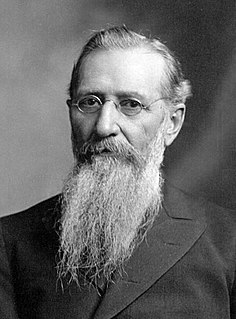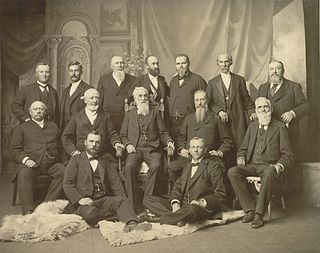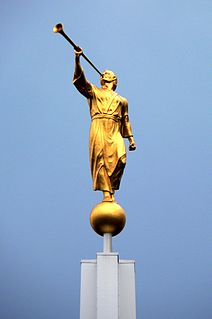An organization is a secondary body of church government within The Church of Jesus Christ of Latter-day Saints (LDS Church) that is "established for moral, educational, and benevolent purposes." [1] Prior to October 2019, the church's organizations were called auxiliary organizations. As the term suggested, the LDS Church's organizations are ancillary to the governing power of the priesthood in the church. The LDS Church's five organizations are Primary, Relief Society, Sunday School, Young Men, and Young Women.

The Church of Jesus Christ of Latter-day Saints, often informally known as the LDS Church or Mormon Church, is a nontrinitarian, Christian restorationist church that is considered by its members to be the restoration of the original church founded by Jesus Christ. The church is headquartered in Salt Lake City, Utah in the United States, and has established congregations and built temples worldwide. According to the church, it has over 16 million members and 65,000 full-time volunteer missionaries. In 2012, the National Council of Churches ranked the church as the fourth-largest Christian denomination in the United States, with over 6.5 million members there as of January 2018. It is the largest denomination in the Latter Day Saint movement founded by Joseph Smith during the early 19th century period of religious revival known as the Second Great Awakening.
In The Church of Jesus Christ of Latter-day Saints, the priesthood is the power and authority to act in the name of God for the salvation of humankind. Male members of the church who meet standards of worthy behavior and church participation are generally ordained to specific offices within the priesthood.

The Primary is a children's organization and an official auxiliary within The Church of Jesus Christ of Latter-day Saints. It acts as a Sunday school organization for the church's children under the age of 12.
The existence of the LDS Church's organizations as a means of assisting the priesthood is based on the Apostle Paul's statement that God has established "helps" and "governments" in the church to assist the apostles and prophets who lead the church. [2] Apostle Harold B. Lee taught that "an auxiliary is to be an aid to the priesthood in watching over the Church and also an aid to the home, under the direction and ... cooperation [of] the priesthood." [3] The purpose of the organizations is to help "plant and make grow ... a testimony of Christ and of the Gospel." [4]
In the Latter Day Saint movement, an apostle is a "special witness of the name of Jesus Christ who is sent to teach the principles of salvation to others." In many Latter Day Saint churches, an apostle is a priesthood office of high authority within the church hierarchy. In many churches, apostles may be members of the Quorum of the Twelve and First Presidency of the church. In most Latter Day Saint churches, modern-day apostles are considered to have the same status and authority as the Biblical apostles.

In religion, a prophet is an individual who is regarded as being in contact with a divine being and is said to speak on that entity's behalf, serving as an intermediary with humanity by delivering messages or teachings from the supernatural source to other people. The message that the prophet conveys is called a prophecy.

Harold Bingham Lee was an American religious leader and educator who served as the 11th president of The Church of Jesus Christ of Latter-day Saints from July 1972 until his death in December 1973.
According to Joseph F. Smith, the church's organizations are temporary organizations which may be created and discontinued as the needs of the church and the priesthood hierarchy change. [5] While serving as the church's president, Smith further stated:

Joseph Fielding Smith Sr. was an American religious leader who served as the sixth president of The Church of Jesus Christ of Latter-day Saints. He was the nephew of Joseph Smith, the founder of the Latter Day Saint movement, and was the last president of the LDS Church to have known him personally.

In The Church of Jesus Christ of Latter-day Saints, the President of the Church is the highest office of the church. It was the office held by Joseph Smith, the church's founder. The President of the LDS Church is the church's leader and the head of the First Presidency, the church's highest governing body. Latter-day Saints consider the president of the church to be a "prophet, seer, and revelator" and refer to him as "the Prophet," a title that was originally given to Smith. When the name of the president is used by adherents, it is usually prefaced by the title "President". Russell M. Nelson has been the president since January 14, 2018.
We expect to see the day, if we live long enough ... when every council of the Priesthood in the Church of Jesus Christ of Latter-day Saints will understand its duty; will assume its own responsibility, will magnify its calling, and fill its place in the Church, to the uttermost, according to the intelligence and ability possessed by it. When that day shall come, there will not be so much necessity for work that is now being done by the auxiliary organizations, because it will be done by the regular quorums of the Priesthood. [6]
In the LDS Church today, each organization is headed by a church-wide "general president" and two counselors; the three individuals together form the organization's "general presidency.". These individuals are not general authorities of the church, but are referred to as "general officers" of the church. Like general authorities, general officers are "accepted and sustained" by the members of the church as leaders in their respective areas of jurisdiction, which are set out by the First Presidency and the Quorum of the Twelve Apostles.

The First Presidency, also called the Quorum of the Presidency of the Church or simply the Presidency), is the presiding or governing body of The Church of Jesus Christ of Latter-day Saints. It is composed of the President of the Church and his counselors. The First Presidency currently consists of Russell M. Nelson and his two counselors: Dallin H. Oaks and Henry B. Eyring.

In The Church of Jesus Christ of Latter-day Saints, the Quorum of the Twelve Apostles is one of the governing bodies in the church hierarchy. Members of the Quorum of the Twelve Apostles are apostles, with the calling to be prophets, seers, and revelators, evangelical ambassadors, and special witnesses of Jesus Christ.
Additionally, each of the organizations exists at a local ward and stake level, with presidencies formed to direct the work of the organization in that particular region, except for the stake Sunday School organization. A member of the stake high council serves as the stake Sunday School president and may serve with or without counselors or a secretary. Leaders of organizations at the ward and stake levels are called "ward officers" and "stake officers," respectively. Local organization presidencies work under the direction of the local priesthood leaders, which in most cases are the bishop and the stake president. Part of the changes announced in October 2019 was to discontinue the presidency of the Young Men at the ward level.

In The Church of Jesus Christ of Latter-day Saints, a ward is the larger of two types of local congregations, the smaller being a branch. A ward is presided over by a bishop, the equivalent of a pastor in many other Christian denominations. As with all local LDS Church leadership, the bishop is considered lay clergy and as such is not paid. Two counselors serve with the bishop to help with administrative and spiritual duties of the ward and to preside in the absence of the bishop. Together, these three men constitute the bishopric. A branch is presided over by a branch president who may also have one or two counselors, depending on the size of the branch. Groups of wards are organized into stakes, while groups of branches are organized into districts.
A stake is an administrative unit composed of multiple congregations in certain denominations of the Latter Day Saint movement. The name "stake" derives from the Book of Isaiah: "enlarge the place of thy tent; stretch forth the curtains of thine habitation; spare not, lengthen thy cords, and strengthen thy stakes". A stake is sometimes referred to as a stake of Zion.
Bishop is the highest priesthood office of the Aaronic priesthood in the Latter Day Saint movement. It is almost always held by one who already holds the Melchizedek priesthood office of high priest. The Latter Day Saint concept of the office differs significantly from the role of bishops in other Christian denominations, being in some respects more analogous to a pastor or parish priest. Each bishop serves with two counselors, which together form a bishopric.



